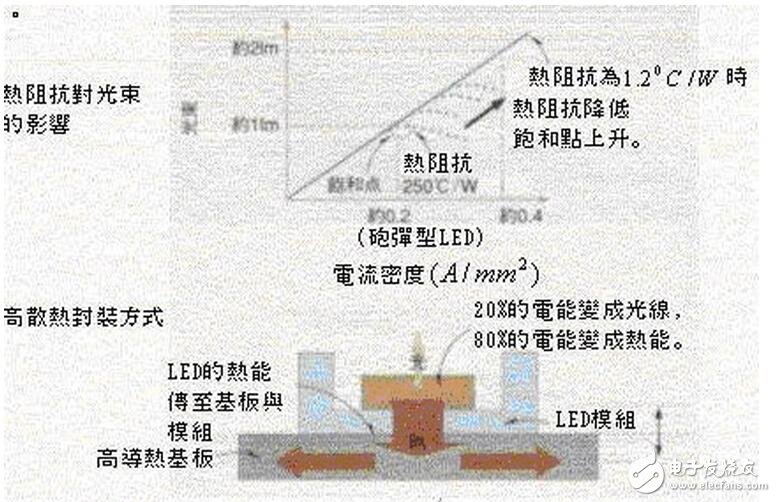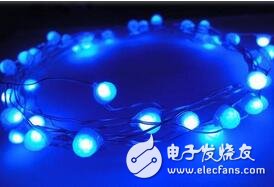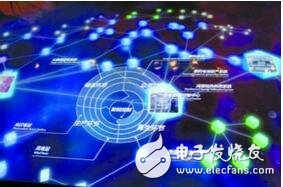Like traditional light sources, semiconductor light-emitting diodes (LEDs) also generate heat during operation, depending on the overall luminous efficiency. Under the action of external electric energy, the radiation of electrons and holes recombines to produce electroluminescence, and the light radiated near the PN junction needs to pass through the semiconductor medium of the chip itself and the encapsulating medium to reach the outside (air). Comprehensive current injection efficiency, radiant luminescence quantum efficiency, chip external light extraction efficiency, etc., finally only 30-40% of the input electrical energy is converted into light energy, and the 鹞60-70% of the energy is mainly caused by non-radiative recombination lattice vibration. The form transforms heat. The increase in the temperature of the chip enhances the non-radiative recombination and further weakens the luminous efficiency. Because people think that high-power LEDs have no heat, in fact, there are. A lot of heat, so that problems occur during use. In addition, many people who use high-power LEDs for the first time do not know how to solve the heat problem effectively, which makes product reliability a major problem. So, is there any heat generated by the LED? How much heat can you produce? How big is the heat generated by the LED? At the forward voltage, the electrons receive energy from the power source. Under the driving of the electric field, the electric field of the PN junction is overcome, and the N region transitions to the P region. These electrons recombine with the holes in the P region. Since the free electrons drifting to the P region have higher energy than the P region valence electrons, the electrons return to the low energy state at the time of recombination, and the excess energy is released in the form of photons. The wavelength at which the photons are emitted is related to the energy difference Eg. It can be seen that the illuminating region is mainly near the PN junction, and the luminescence is the result of the combination of electrons and holes releasing energy. With a semiconductor diode, electrons encounter resistance throughout the journey from the semiconductor region to the semiconductor region. Simply from the principle, the physical structure of the semiconductor diode is simply from the principle, the physical structure of the semiconductor diode is equal to the electrons emitted from the negative electrode and the number of electrons returning to the positive electrode. In a common diode, in the recombination of electron-hole pairs, the photon spectrum released is not in the visible range due to the difference in energy level Eg. When electrons are inside the diode, power is consumed due to the presence of resistance. The power consumed is in accordance with the basic laws of electronics: P =I2 R =I2(RN ++RP )+IVTH Where: RN is the N-body resistance and RP is the P-region resistance. The heat generated by the power consumed is: Q = Pt Where: t is the time when the diode is energized. In essence, the LED is still a semiconductor diode. Therefore, when the LED is working in the forward direction, its working process conforms to the above description. The electric power it consumes is: P LED = U LED &TImes; I LED Where: U LED is the forward voltage across the LED source The I LED is the current that flows through the LED. These consumed electrical power is converted into heat release: Q=P LED &TImes; t Where: t is the power-on time In fact, the energy released by the electrons in the P region and the holes are not directly supplied by the external power source, but because the electrons are in the N region, when there is no external electric field, its energy level is better than that of the P region. The valence electron energy level is higher than Eg. When it reaches the P zone, it recombines with the hole to become the valence electron of the P zone, and it releases this? N more energy. The size of the Eg is determined by the material itself and is independent of the external electric field. The effect of the external power supply on the electrons is only to push it to do directional movement and overcome the role of the PN junction. The heat production of LEDs has nothing to do with light efficiency. A few percent of the electrical power does not produce light, and a few percent of its electrical power creates a thermal relationship. Through the understanding of high-power LED heat generation, thermal resistance, junction temperature concept and theoretical formula derivation and thermal resistance measurement, we can study the actual package design, evaluation and product application of high-power LED. It should be noted that thermal management is a key issue at the current stage of low luminous efficiency of LED products. It is the bottom line to fundamentally improve the luminous efficiency to reduce the generation of thermal energy, which requires chip manufacturing, LED packaging and application product development. Advances in technology at all stages. With the development of technology, the power of LEDs is constantly increasing, but the cost is decreasing. The use of low-cost, high-reliability drive circuits is the key to ensuring long-lasting brightness of ultra-high-brightness LEDs. According to the characteristics of high-brightness LED high-power constant-current driving, many companies have introduced dedicated drive control chips for high-brightness LEDs. These LED driver IC manufacturers include Melexis and lnfinton (Infineon). With the development of technology, the power of LEDs is constantly increasing, but the cost is decreasing. The use of low-cost, high-reliability drive circuits is the key to ensuring long-lasting brightness of ultra-high-brightness LEDs. According to the characteristics of high-brightness LED high-power constant-current driving, many companies have introduced dedicated driver control chips for high-brightness LEDs. These LED driver IC manufacturers include Melexis, lnfinton (Infineon) and Lienear Technology (Liner Technology). ), Supenex Inc, Analog Devices (ADI), Leadtrend, Anmo Microelectronics (AME), China Resources Converse, and more. Compared with traditional lighting, super bright LEDs have long life, reliability and durability, and extremely low maintenance costs. The current high efficiency of LEDs can now reach more than 201m/w. Since the LED response speed is fast (ns level), installing a high-position LED brake light on the car can reduce the occurrence of a rear-end collision accident. Although super bright LEDs have many advantages, LED power is still below 5W, and it has not appeared yet. More powerful LEDs are hard to become the first choice for lighting. At the same time, we must consider the high-power LED needs to consider the heat dissipation problem. If the junction temperature is too high, it will directly affect the life of the LED, and it will increase the light decay of the LED. If the LED is burnt out, the LED will burn out. In addition to the above problems, although LED is currently favored by most people, its high price is difficult to be accepted by consumers. And having a good super bright LED can not solve all the problems. Choosing the appropriate driver chip is also conducive to the popularization and promotion of super bright LED. It has been found in the LED industry that the use of a constant voltage source drive does not guarantee the uniformity of LED brightness and affects the reliability, lifetime and light decay of the LED. Therefore, super bright LEDs are usually driven by a constant current source. The constant current supply eliminates current changes caused by forward voltage changes. This produces a constant LED brightness regardless of the forward current. It is easy to generate a constant current power supply. It is only necessary to adjust the voltage across the current sense resistor without adjusting the output voltage of the power supply. Compared with the performance of the current main high-power IED driver control chip, when applying the high-power IED driver control chip, it can be selected according to different applications: 1. When higher power is required, the power device can be selected without the controller integrated in the chip, so that the power device can be separately selected according to the actual power requirement. 2. When a higher conversion efficiency is required, such as a portable device, a drive circuit of a switching power supply type can be selected. 3. When applied to equipment with high reliability, you can choose a chip with comprehensive control functions such as temperature protection and fault alarm.
Saintish Lithium Deep Cycle Batteries provide 5 years full replacement warranty, the batteries are consists of prismatic cells which are A grade Auto level. Each lithium battery includes an integrated Battery Monitoring System(BMS) to protect battery from over charge/discharge, over temperature and short circuit. The Bluetooth App installed on mobile enable users to monitor battery status easily.
The 12V lithium-ion batteries are perfect for solar system, Caravan, RVs, campers, Yacht, off-grid applications and lead acid replacement. Lithium Deep Cycle Battery, Lithium Battery Manufacturer, Lithium Iron Batteries 12V, Lithium Batteries for Caravans Hangzhou Saintish Technology Co.,Ltd. , https://www.saintishtech.com




How to prevent and reduce the generation of LED heat, how many tips for LED IC selection
LED heat prevention and reduction: